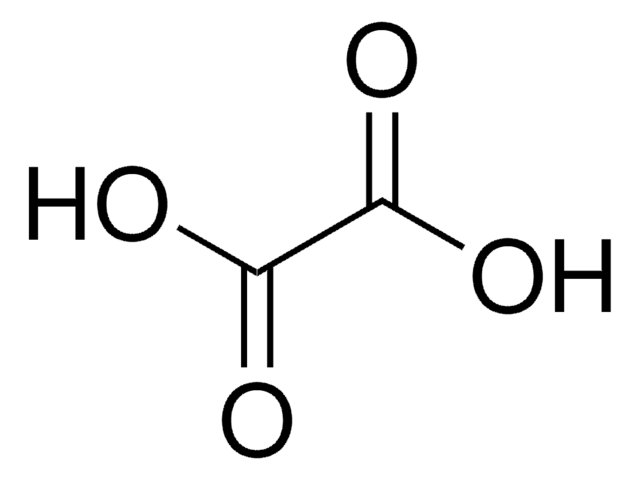94916
DL-Malic acid
analytical standard
Synonyme(s) :
(±)-2-Hydroxysuccinic acid, DL-Hydroxybutanedioic acid
About This Item
Produits recommandés
Qualité
analytical standard
Niveau de qualité
Densité de vapeur
4.6 (vs air)
Pression de vapeur
<0.1 mmHg ( 20 °C)
Température d'inflammation spontanée
644 °F
Durée de conservation
limited shelf life, expiry date on the label
Concentration
95.0-105.0 wt. % (NaOH 0.1M, Titration)
Technique(s)
HPLC: suitable
gas chromatography (GC): suitable
Pf
131-133 °C (lit.)
Solubilité
H2O: soluble 646.6 g/L at 20 °C
Application(s)
cleaning products
cosmetics
flavors and fragrances
food and beverages
personal care
Format
neat
Température de stockage
2-8°C
Chaîne SMILES
OC(CC(O)=O)C(O)=O
InChI
1S/C4H6O5/c5-2(4(8)9)1-3(6)7/h2,5H,1H2,(H,6,7)(H,8,9)
Clé InChI
BJEPYKJPYRNKOW-UHFFFAOYSA-N
Vous recherchez des produits similaires ? Visite Guide de comparaison des produits
Description générale
Find all available reference materials for compounds listed in 10/2011 here
Application
Mention d'avertissement
Warning
Mentions de danger
Conseils de prudence
Classification des risques
Eye Irrit. 2
Code de la classe de stockage
11 - Combustible Solids
Classe de danger pour l'eau (WGK)
WGK 1
Point d'éclair (°F)
397.4 °F
Point d'éclair (°C)
203 °C
Faites votre choix parmi les versions les plus récentes :
Déjà en possession de ce produit ?
Retrouvez la documentation relative aux produits que vous avez récemment achetés dans la Bibliothèque de documents.
Les clients ont également consulté
Protocoles
Separation of Pyruvic acid, United States Pharmacopeia (USP) Reference Standard; Tartaric acid, United States Pharmacopeia (USP) Reference Standard; Citric acid, United States Pharmacopeia (USP) Reference Standard; Malic acid, United States Pharmacopeia (USP) Reference Standard; L-Pyroglutamic acid, ≥99.0% (T); Lactic acid, United States Pharmacopeia (USP) Reference Standard; Acetic acid, ≥99.99% trace metals basis; Succinic acid, United States Pharmacopeia (USP) Reference Standard
Notre équipe de scientifiques dispose d'une expérience dans tous les secteurs de la recherche, notamment en sciences de la vie, science des matériaux, synthèse chimique, chromatographie, analyse et dans de nombreux autres domaines..
Contacter notre Service technique

